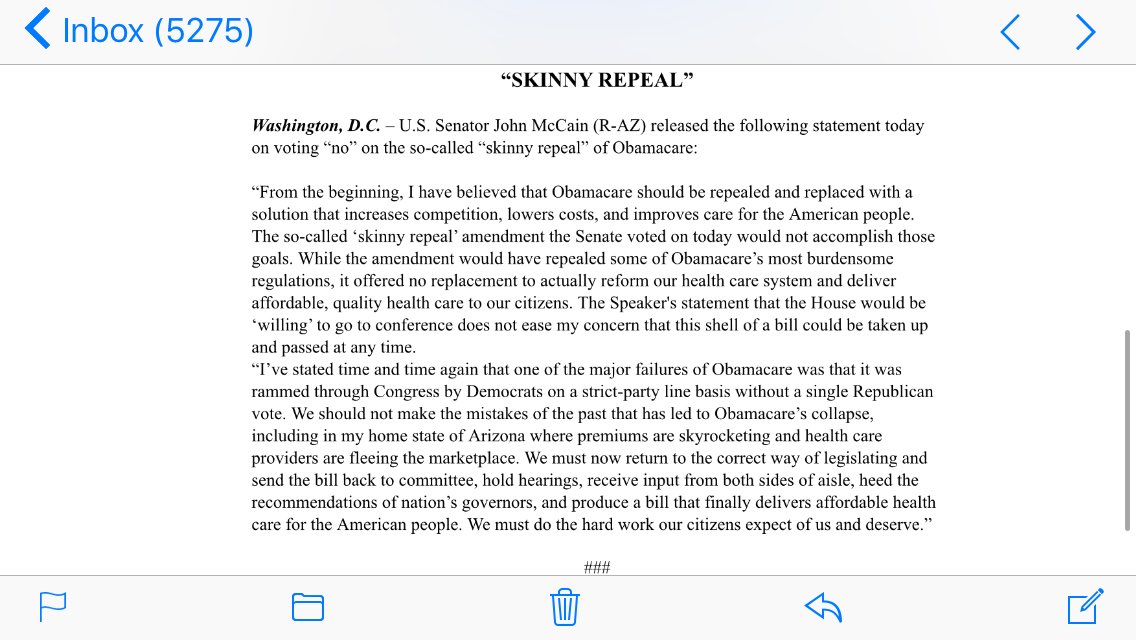McCain's capture and subsequent imprisonment began on October 26, 1967. He was flying his 23rd bombing mission over Hanoi in North Vietnam when his A-4E Skyhawk was shot down by a missile.[34][35] McCain fractured both arms and a leg when he ejected from the aircraft,[36] and nearly drowned after he parachuted into Trúc Bạch Lake.[34] Some North Vietnamese pulled him ashore, then others crushed his shoulder with a rifle butt and bayoneted him.[34] McCain was then transported to Hanoi's main Hỏa Lò Prison, nicknamed the "Hanoi Hilton".[35]
Although McCain was seriously wounded and injured, his captors refused to treat him. They beat and interrogated him to get information, and he was given medical care only when the North Vietnamese discovered that his father was a high-ranking admiral.[37] His status as a prisoner of war (POW) made the front pages of major newspapers.[38][39]
McCain spent six weeks in the hospital, where he received marginal care.[34] He had lost 50 pounds (23 kg), was in a chest cast, and his gray hair had turned as white as snow.[34] McCain was sent to a different camp on the outskirts of Hanoi.[40] In December 1967, McCain was placed in a cell with two other Americans who did not expect him to live more than a week.[41] In March 1968, McCain was placed into solitary confinement, where he would remain for two years.[42]
In mid-1968, John S. McCain Jr. was named commander of all U.S. forces in the Vietnam theater, and the North Vietnamese offered McCain early release[43] because they wanted to appear merciful for propaganda purposes,[44] and also to show other POWs that elite prisoners were willing to be treated preferentially.[43] McCain refused repatriation unless every man taken in before him was also released. Such early release was prohibited by the POWs' interpretation of the military Code of Conduct: to prevent the enemy from using prisoners for propaganda, officers were to agree to be released in the order in which they were captured.[34]
Beginning in August 1968, McCain was subjected to a program of severe torture.[45] He was bound and beaten every two hours; this punishment occurred at the same time that he was suffering from dysentery.[34][45] Further injuries led McCain to attempt suicide, which was stopped by guards.[34] Eventually, McCain made an anti-American propaganda "confession".[34] He has always felt that his statement was dishonorable, but as he later wrote, "I had learned what we all learned over there: every man has his breaking point. I had reached mine."[46][47] Many American POWs were tortured and maltreated in order to extract "confessions" and propaganda statements;[48] virtually all of them eventually yielded something to their captors.[49] McCain received two to three beatings weekly because of his continued refusal to sign additional statements.[50]
McCain refused to meet various anti-war groups seeking peace in Hanoi, wanting to give neither them nor the North Vietnamese a propaganda victory.[51] From late 1969, treatment of McCain and many of the other POWs became more tolerable,[52] while McCain continued actively to resist the camp authorities.[53] McCain and other prisoners cheered the U.S. "Christmas Bombing" campaign of December 1972, viewing it as a forceful measure to push North Vietnam to terms.[47][54]
McCain was a prisoner of war in North Vietnam for five and a half years. He was released on March 14, 1973.[55] His wartime injuries left him permanently incapable of raising his arms above his head.[56]





